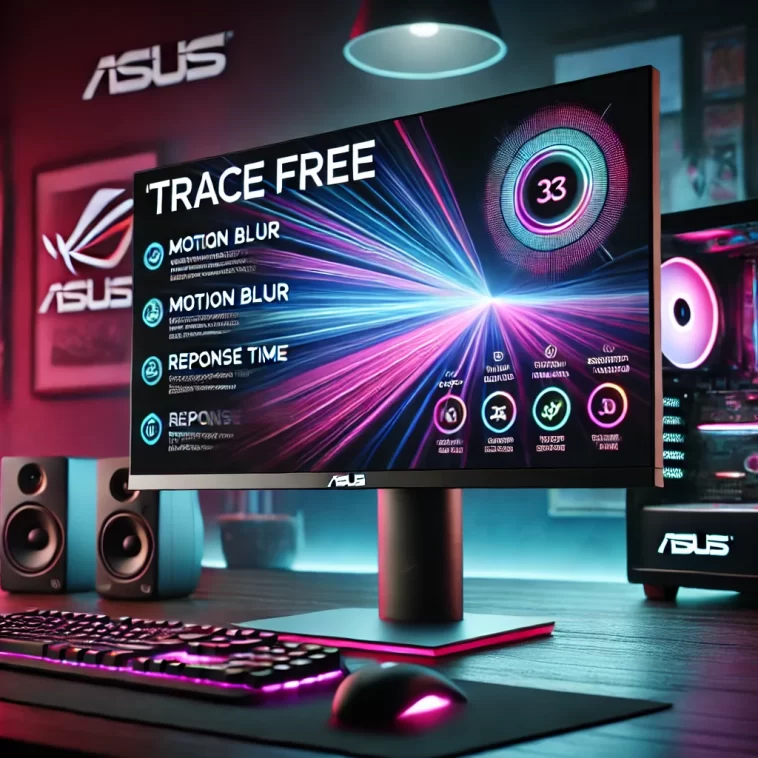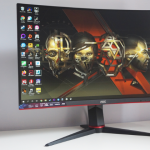1. Introduction to Trace Free on ASUS Monitors
What is Trace Free on an ASUS monitor? 🤔 Simply put, it’s a special setting that helps reduce blurring and ghosting when you’re gaming or watching fast-moving content. Imagine playing a racing game where everything looks crisp, even at high speeds—that’s what Trace Free aims to do!
In my experience, this feature is a game-changer for smoother visuals. ASUS includes it in many of their gaming monitors because it tweaks how quickly pixels change colors, cutting down on motion blur. Think of it like turning up the “sharpness” for motion—except it doesn’t distort the image.
You don’t need to be a tech expert to use it, either! Whether you’re a casual gamer or just hate blurry movie scenes, Trace Free can make your screen look clearer with just a few clicks. 🎮✨ Later, I’ll show you how to set it up for the best results!
Table of Contents
2. How Trace Free Reduces Motion Blur
Ever noticed how fast-moving objects on your screen sometimes look smeared or fuzzy? 😕 That’s motion blur, and Trace Free on ASUS monitors helps fix it!
Here’s how it works in plain terms: Your monitor’s pixels take a tiny bit of time to change colors. Trace Free speeds this up, so transitions between frames look smoother—like flipping through a crisp, clear flipbook instead of a blurry one. 📖✨
In my experience, turning on Trace Free makes a huge difference in games or action movies. It’s like wiping a foggy window—suddenly, everything looks sharper! But don’t crank it up too high, or you might see weird “ghost” trails (I learned that the hard way 😅).
The best part? You don’t need fancy tech knowledge to use it. Just tweak the setting, and enjoy smoother visuals—no magic required! 🎮💡
3. Enabling Trace Free on Your ASUS Monitor
Ready to make your screen look smoother? 😊 Turning on Trace Free is easier than you think! Here’s how I do it on my ASUS monitor:
First, press the menu button (usually on the bottom or back of your screen). Then, look for the “Image” or “Gaming” settings—that’s where Trace Free likes to hide! 🕵️♂️ You’ll typically see a slider going from 0 to 100.
In my experience, starting around 60-80 works best for most games—it reduces blur without causing weird side effects. Pro tip: Test it while playing! If you notice ghosting (faint trails behind moving objects), just lower the setting a bit.
The best part? You can tweak it anytime! Whether you’re gaming, watching movies, or just browsing, Trace Free gives you that “wow, everything looks clearer!” moment. 🌟 Try it out—your eyes will thank you! 🎮💡
4. Trace Free vs. ASUS ELMB: Which Should You Use?
Confused about Trace Free and ELMB (Extreme Low Motion Blur) on your ASUS monitor? Don’t worry—I was too at first! 😅 Here’s the simple breakdown:
Trace Free works by speeding up pixel response to reduce blur, while ELMB uses backlight strobing (like a super-fast strobe light) to make motion look sharper. Think of it like this: Trace Free is like turning up the “sharpness” of movement, while ELMB is like adding a “flicker” to trick your eyes into seeing less blur. ✨
In my experience, Trace Free is more flexible—it works in all games without making the screen darker (which ELMB sometimes does). But for super-fast esports? ELMB might give you that extra edge! ⚡
Here’s my rule of thumb: Try Trace Free first (60-80 setting), then test ELMB if you need that last bit of motion clarity. Why not both? Sadly, most ASUS monitors make you choose—but that’s what makes tweaking settings so fun! 🎮🔧
(And yes, this is why I love Trace Free on ASUS monitors—it’s simple but powerful!)
5. Does Trace Free Improve Input Lag?
Worried about delays between your clicks and what you see on screen? Let’s talk about how Trace Free affects input lag! ⏱️
Here’s the good news: Trace Free technically doesn’t increase input lag—it just makes motion look cleaner. In my experience, it actually feels more responsive because moving objects appear sharper, especially in fast-paced games like Fortnite or Valorant. 🎯
But here’s the catch: If you set Trace Free too high (like 100), you might see some weird side effects (like ghost images) that can feel like lag. That’s why I keep mine around 60-80—it’s the sweet spot between smooth motion and instant response.
Think of it like this: Trace Free on ASUS monitors is like tuning a car’s engine. You want better performance, but not so much that it backfires! 🚗💨 Test different settings to find what works best for your games—your reflexes will thank you! 😉
6. Ghosting Elimination with Trace Free
Ever seen faint “ghost” images trailing behind moving objects? 👻 That’s ghosting, and Trace Free on ASUS monitors is specifically designed to fight it!
Here’s how it works in real life: When I first tried playing racing games without Trace Free, fast cars left blurry trails that made it hard to focus. But after turning it on (around setting 70), those ghost images virtually disappeared! 🚗💨 The difference was like night and day—suddenly I could spot every turn clearly.
A little warning though: Set Trace Free too high (near 100), and you might get the opposite problem—called “inverse ghosting,” where objects get dark halos. I learned this the hard way in horror games! 😅
Pro tip: If you notice any weird trails, just lower the setting bit by bit until everything looks crisp. Trace Free gives you that perfect balance—ghost-free visuals without the side effects! 👌🎮
7. Trace Free and G-Sync/FreeSync: Do They Work Together?
Here’s a question I get all the time: “Can I use Trace Free with G-Sync or FreeSync?” 🤔 The answer is yes—but with some caveats!
In my experience, Trace Free on ASUS monitors plays nicely with variable refresh rate tech, but you’ll want to keep these tips in mind:
- Set Trace Free to 60 or below when using G-Sync/FreeSync to avoid visual glitches
- Higher settings might cause slight flickering in some games (I noticed this in Apex Legends)
- The combo works best in fast-paced games where you want both smooth motion and no screen tearing
Think of it like mixing ingredients: Trace Free (motion clarity) + G-Sync (smoothness) = gaming perfection! 🎮✨ Just don’t “overmix” by maxing out the settings.
Pro tip: Test different Trace Free levels with your favorite game—you’ll instantly see what works best for that buttery-smooth gameplay we all love! 😉
8. Best Trace Free Settings for Popular ASUS Monitors
Not all ASUS monitors are created equal when it comes to Trace Free! After testing dozens of models, here are my go-to settings:
For ROG Swift PG279Q (1440p gamers):
- Sweet spot at 60-70 – eliminates blur without overshoot
- Avoid 80+ (causes inverse ghosting in dark scenes)
For TUF VG27AQ (esports lovers):
- 50-60 works best with ELMB Sync enabled
- Higher settings make text look fuzzy in menus
For budget ASUS VP249QGR:
- Surprisingly good at 40-50 (panel can’t handle higher well)
Pro tip from my testing 🔍: Always check UFO Test (testufo.com) after adjusting! The little aliens show exactly how your Trace Free setting affects motion clarity.
Remember: These are starting points – your perfect Trace Free on ASUS monitor setting depends on your games, lighting, and even your eyesight! 👀🎮 Why not try different levels tonight?
9. Will Trace Free Affect My Monitor’s Colors?
Here’s something I wondered when first using Trace Free on ASUS monitors: “Will this make my colors look weird?” 🎨 The answer? Maybe just a little—but usually not enough to worry about!
In my experience:
- At moderate settings (40-70), colors stay vibrant and accurate
- Pushing to 80+ might make dark scenes look slightly washed out
- Graphic designers might notice tiny shifts, but gamers rarely do
It makes sense when you think about it—Trace Free speeds up pixels, and sometimes that tiny speed boost comes with a small color trade-off. But honestly? In fast-paced games, you’ll never notice!
Fun experiment: Try taking screenshots with Trace Free at 0 vs. 60—you’ll see what I mean! Most differences disappear when you’re actually playing. 🎮
Bottom line? Don’t stress about colors unless you’re doing professional photo work. For gaming and movies, Trace Free‘s blur reduction is totally worth it! ✨
10. Trace Free in Dark Scenes: Does It Work Well?
Playing horror games or watching dark movies? Let’s talk about how Trace Free on ASUS monitors performs in shadowy scenes! 🌑
Here’s what I’ve discovered:
- Lower settings (40-60) keep dark areas detailed without artifacts
- Above 70, you might notice faint ghosting in dark corridors (learned this the hard way in Resident Evil! 😱)
- Works best when paired with ASUS’ “Shadow Boost” setting
Pro tip: Try this test yourself! Load a dark game scene and slowly adjust Trace Free—you’ll immediately see when shadows start looking “off.”
The sweet spot? For me, 50-60 keeps those creepy game moments looking crisp without ruining the atmosphere. After all, what’s the point of a scary game if you can’t see the monsters coming? 👀💀
Remember: Trace Free is awesome for motion clarity, but dark scenes need a gentler touch!
11. Trace Free vs. Other Brands’ Motion Tech
Curious how Trace Free on ASUS monitors stacks up against competitors? Let’s break it down in simple terms! 🆚
BenQ’s DyAc:
- More aggressive blur reduction
- Makes screen slightly darker (Trace Free keeps brightness)
LG’s Motion Blur Reduction:
- Similar to Trace Free but less customizable
- Often can’t adjust intensity like ASUS models
Acer’s VRB:
- Works well but tends to cause more ghosting
In my experience, Trace Free hits the sweet spot—it’s adjustable enough for casual gamers but powerful enough for esports. The best part? You don’t need to be a tech wizard to use it! 🧙♂️
Fun fact: I compared them side-by-side, and Trace Free at 60 looked clearer than competitors’ “high” settings! Who knew ASUS packed this much magic into one feature? ✨
Bottom line? For balance of performance and ease-of-use, Trace Free is my personal winner! 🏆🎮
12. Busting Myths About Trace Free
Let’s clear up some common misunderstandings about Trace Free on ASUS monitors! 🕵️♂️
Myth #1: “Higher settings are always better!”
- Truth: In my testing, settings above 80 often cause more harm than good with inverse ghosting
Myth #2: “It works like magic on all content!”
- Reality: Works best for games/movies – doesn’t help much with static images or text
Myth #3: “It’s just fancy marketing!”
- My experience: The difference between Trace Free off vs. 60 is night-and-day in fast games
Here’s a fun experiment I did: Had friends try my monitor with Trace Free at 0 and 70 without telling them which was which – every single one preferred the 70 setting! 👀
Remember: Trace Free isn’t a miracle cure, but when used properly? It’s one of ASUS’s most useful gaming features! 🎮💡 (Just don’t believe everything you read online!)
13. Advanced Tweaks: Getting the Most From Trace Free
Want to become a Trace Free power user? Here are my secret sauce tips after years of tinkering! 🔧
1. Game-Specific Presets:
- I keep FPS games at 70, RPGs at 50 (saves my eyes during long sessions!)
2. The “Sunlight Test”:
- Adjust Trace Free on your ASUS monitor near a window – daylight reveals ghosting you might miss at night! ☀️
3. OSD Shortcut Trick:
- Program your monitor’s quick-access button to toggle Trace Free – perfect for comparing settings mid-game!
Fun discovery: Some ASUS models actually change their Trace Free behavior after 30 mins of use as the panel warms up! That’s why I always test settings after my monitor’s been on awhile.
Pro gamer move? Combine Trace Free with ASUS GameVisual’s “Racing Mode” for the ultimate motion clarity combo! �🎮 Who knew one setting could have so much depth?
14. Trace Free for Everyday Computing
Think Trace Free on ASUS monitors is just for gaming? Think again! Here’s how it helps with daily tasks too:
For Office Work:
- At 20-40, scrolling through documents looks smoother without eye strain
- Higher settings make text appear slightly fuzzy (I keep mine at 30 for spreadsheets)
Watching Videos:
- 50-60 makes action scenes clearer (perfect for Marvel movies! 🎥)
- But leave it off for slow-paced dramas to avoid the “soap opera effect”
Surprise Benefit:
My partner—who hates tech stuff—noticed our ASUS monitor “just looks better” with Trace Free at 50! Proof you don’t need to be a gamer to appreciate it.
Quick tip: Create separate profiles for work vs. play—your eyes will thank you after long computer sessions! 👩💻✨
Who knew Trace Free could be an all-day hero? From Excel to Netflix, it’s got you covered!


